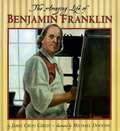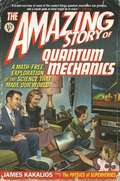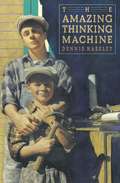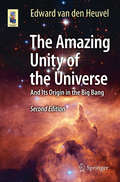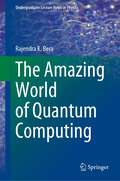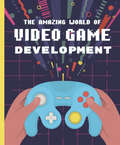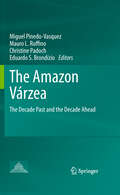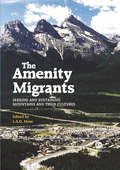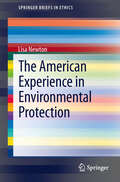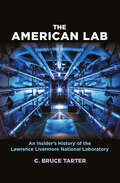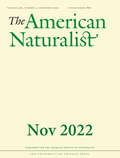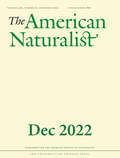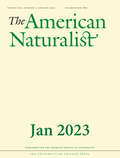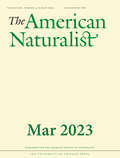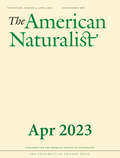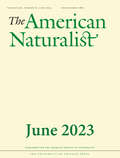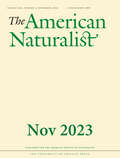- Table View
- List View
The Amazing Life of Benjamin Franklin
by James Cross GiblinA biography of the eighteenth-century printer, inventor, and statesman who played an influential role in the early history of the United States.
The Amazing Story of Quantum Mechanics
by James KakaliosIn the pulp magazines and comics of the 1950s, it was predicted that the future would be one of gleaming utopias, with flying cars, jetpacks, and robotic personal assistants. Obviously, things didn't turn out that way. But the world we do have is actually more fantastic than the most outlandish predictions of the science fiction of the mid-20th century. The World Wide Web, pocket-sized computers, mobile phones and MRI machines have changed the world in unimagined ways. In The Amazing Story of Quantum Mechanics, James Kakalios uses examples from comics and magazines to explain how breakthroughs in quantum mechanics led to such technologies. The book begins with an overview of speculative science fiction, beginning with Jules Verne and progressing through the space adventure comic books of the 1950s. Using the example of Dr. Manhattan from the graphic novel and film Watchmen, Kakalios explains the fundamentals of quantum mechanics, and describes nuclear energy via the hilarious portrayals of radioactivity and its effects in the movies and comic books of the 1950s. Finally, he shows how future breakthroughs will make possible ever more advanced medical diagnostic devices - and perhaps even power stations on the moon that can beam their power to earth.
The Amazing Thinking Machine
by Dennis HaseleyDuring the Great Depression, while their father is away looking for work, eight-year-old Patrick and thirteen-year-old Roy create a machine to help their mother make ends meet, even as she is helping tramps.
The Amazing Unity of the Universe
by Edward van den HeuvelIn the first chapters the author describes how our knowledge of the position of Earth in space and time has developed, thanks to the work of many generations of astronomers and physicists. He discusses how our position in the Galaxy was discovered, and how in 1929, Hubble uncovered the fact that the Universe is expanding, leading to the picture of the Big Bang. He then explains how astronomers have found that the laws of physics that were discovered here on Earth and in the Solar System (the laws of mechanics, gravity, atomic physics, electromagnetism, etc. ) are valid throughout the Universe. This is illustrated by the fact that all matter in the Universe consists of atoms of the same chemical elements that we know on Earth. This unity is all the more surprising when one realizes that in the original Big Bang theory, different parts of the Universe could never have communicated with each other. It then is a mystery how they could have shared the same physical laws. This problem was solved by the introduction of the idea of Inflation, a phase of extremely rapid expansion of the Universe during the first fraction of a second following the Big Bang. The author explains how the unity of the universe finds its origin in the Big Bang prior to inflation. The book addresses the many fundamental questions about the Universe and its contents from the perspective of the Big Bang: the formation of structure in the Universe, the questions of the mysterious dark matter and dark energy, the possibilities of other universes (the Multiverse) and of the existence of intelligent life elsewhere in the Universe.
The Amazing World of Flyingfish
by Steve N. HowellA one-of-a-kind illustrated book that presents flyingfish as you've never seen them beforeIf you travel the open ocean anywhere in the tropics, you are very likely to see flyingfish. These beautifully colored "ocean butterflies" shoot out of the water and sail on majestic, winglike pectoral fins to escape from predators such as dolphins, swordfish, and tuna. Some can travel for more than six hundred feet per flight. Yet despite their prevalence in warm ocean waters and their vital role in the tropical food chain, surprisingly little is known about flyingfish—more than 60 species are said to exist, but nobody is sure of the number. This beautifully illustrated book presents flyingfish as you've never seen them before. It features more than 90 stunning color photos by renowned naturalist Steve Howell, as well as a concise and accessible text that explores the natural history of flyingfish, where they can be found, how and why they fly, what colors they are, what they eat and what eats them, and more.The ideal gift for fish lovers, seasoned travelers, and armchair naturalists alike, this first-of-its-kind book provides a rare and incomparable look at these spectacular marine creatures.Presents flyingfish like you’ve never seen them beforeFeatures more than 90 stunning color imagesExplores the natural history of flyingfish, where to see them, how they fly, and moreThe ideal gift book for fish lovers, ecotravelers, birders, and armchair naturalists
The Amazing World of Quantum Computing (Undergraduate Lecture Notes in Physics)
by Rajendra K. BeraThis book discusses the application of quantum mechanics to computing. It explains the fundamental concepts of quantum mechanics and then goes on to discuss various elements of mathematics required for quantum computing. Quantum cryptography, waves and Fourier analysis, measuring quantum systems, comparison to classical mechanics, quantum gates, and important algorithms in quantum computing are among the topics covered.The book offers a valuable resource for graduate and senior undergraduate students in STEM (science, technology, engineering, and mathematics) fields with an interest in designing quantum algorithms. Readers are expected to have a firm grasp of linear algebra and some familiarity with Fourier analysis.
The Amazing World of Video Game Development
by Denis GalaninThe perfect book for any child who is interested in making a career out of video games, learn about the different roles within a game development company and how a game goes from a thought to a program.
The Amazon Várzea: The Decade Past and the Decade Ahead
by Christine Padoch Mauro L. Ruffino Miguel Pinedo-Vasquez Eduardo S. BrondízioThis book takes a multi-disciplinary and critical look at what has changed over the last ten years in one of the world's most important and dynamic ecosystems, the Amazon floodplain or várzea. It also looks forward, assessing the trends that will determine the fate of environments and people of the várzea over the next ten years and providing crucial information that is needed to formulate strategies for confronting these looming realities.
The Amenity Migrants: Seeking and Sustaining Mountains and Their Cultures
by Laurence A. G. MossPlaces with perceived high environmental quality and distinctive culture are globally attracting amenity migrants. Today this societal driving force is particularly manifest in mountain areas, and while beneficial for both the new comers and locals, is also threatening highland ecologies and their human communities. This book describes and analyzes the challenges and opportunities of amenity migration and its management, and offers related recommendations. The book's chapters cover the subject through case studies at international, regional and local levels, along with overarching themes such as environmental sustainability and equity, mountain recreation users, housing, and spiritual motivation. A crucial issue addressed is the relationship of amenity migration to tourism, and migration motivated by economic gain. The introduction and concluding chapters bring all of the information and analyses together strategically, summarizing in a manner of theoretical and practical value for both academics and practitioners.
The American Experience in Environmental Protection
by Lisa NewtonThis book tracks the growth of environmental awareness and conservation in the United States through the major trends of the 20th century, and establishes a philosophical ground for protection of the environment. It records a major cultural shift in the thinking of this nation, and provides guidelines for its continuation.
The American Farmer and the New Deal
by Theodore SaloutosThird volume of a trilogy of agricultural history preceded by Agricultural Discontent in the Middle West, 1900-1939 & Farmer Movements in the South, 1865-1933. The American Farmer and the New Deal focuses on the challenges of the New Dealers in agriculture; the farm strikes, relations among the laborers and sharecroppers, the drought seasons, the dust storms, and tenants as well as it tries to come up with solutions to this difficulties
The American Lab: An Insider’s History of the Lawrence Livermore National Laboratory (Johns Hopkins Nuclear History and Contemporary Affairs)
by C. Bruce TarterBehind the scenes of the Lawrence Livermore National Laboratory, the quintessential American lab.Nobel laureate Ernest O. Lawrence and renowned physicist Edward Teller founded the Lawrence Livermore National Laboratory in 1952. A new ideas incubator, the Lab was at the heart of nuclear testing and the development of supercomputers, lasers, and other major technological innovations of the second half of the twentieth century. Many of its leaders became prominent figures in the technical and defense establishments, and by the end of the 1960s, Livermore was the peer of Los Alamos National Lab, a relationship that continues today.In The American Lab, former Livermore director C. Bruce Tarter offers unparalleled access to the inner workings of the Lab. Touching on Cold War nuclear science and the technological shift that occurred after the fall of the Berlin Wall, he traces the Lab’s evolution from its founding under University of California management through its transfer to private oversight. Along the way, he highlights important episodes in that journey, from the invention of Polaris, the first submarine-launched ballistic missile, to the Lab’s controversial role in the Star Wars program. He also describes Livermore’s significant responsibilities in stockpile stewardship, the program that ensures the safety and reliability of the US nuclear arsenal. The book portrays the lab’s extensive work on thermonuclear fusion, a potential source of unlimited energy; describes the development of the world’s largest laser fusion installation, the National Ignition Facility; and examines a number of smaller projects, such as the Lab’s participation in founding the Human Genome Project. Finally, it traces the relationship of the Lab to its federal sponsor, the Department of Energy, as it evolved from partnership to compliance with orders, a shift that affected all of the national laboratories. Drawing on oral histories, internal laboratory documents, and the author’s personal experiences from more than fifty years as a Lab employee, The American Lab is an illuminating history of the Lab and its revolutionary work.
The American Naturalist, volume 200 number 5 (November 2022)
by The American NaturalistThis is volume 200 issue 5 of The American Naturalist. Since its inception in 1867, The American Naturalist has maintained its position as one of the world’s premier peer-reviewed publications in ecology, evolution, and behavior research. Its goals are to publish articles that are of broad interest to the readership, pose new and significant problems, introduce novel subjects, develop conceptual unification, and change the way people think. The American Naturalist emphasizes sophisticated methodologies and innovative theoretical syntheses — all in an effort to advance the knowledge of organic evolution and other broad biological principles.
The American Naturalist, volume 200 number 6 (December 2022)
by The American NaturalistThis is volume 200 issue 6 of The American Naturalist. Since its inception in 1867, The American Naturalist has maintained its position as one of the world’s premier peer-reviewed publications in ecology, evolution, and behavior research. Its goals are to publish articles that are of broad interest to the readership, pose new and significant problems, introduce novel subjects, develop conceptual unification, and change the way people think. The American Naturalist emphasizes sophisticated methodologies and innovative theoretical syntheses — all in an effort to advance the knowledge of organic evolution and other broad biological principles.
The American Naturalist, volume 201 number 1 (January 2023)
by The American NaturalistThis is volume 201 issue 1 of The American Naturalist. Since its inception in 1867, The American Naturalist has maintained its position as one of the world’s premier peer-reviewed publications in ecology, evolution, and behavior research. Its goals are to publish articles that are of broad interest to the readership, pose new and significant problems, introduce novel subjects, develop conceptual unification, and change the way people think. The American Naturalist emphasizes sophisticated methodologies and innovative theoretical syntheses — all in an effort to advance the knowledge of organic evolution and other broad biological principles.
The American Naturalist, volume 201 number 2 (February 2023)
by The American NaturalistThis is volume 201 issue 2 of The American Naturalist. Since its inception in 1867, The American Naturalist has maintained its position as one of the world’s premier peer-reviewed publications in ecology, evolution, and behavior research. Its goals are to publish articles that are of broad interest to the readership, pose new and significant problems, introduce novel subjects, develop conceptual unification, and change the way people think. The American Naturalist emphasizes sophisticated methodologies and innovative theoretical syntheses — all in an effort to advance the knowledge of organic evolution and other broad biological principles.
The American Naturalist, volume 201 number 3 (March 2023)
by The American NaturalistThis is volume 201 issue 3 of The American Naturalist. Since its inception in 1867, The American Naturalist has maintained its position as one of the world’s premier peer-reviewed publications in ecology, evolution, and behavior research. Its goals are to publish articles that are of broad interest to the readership, pose new and significant problems, introduce novel subjects, develop conceptual unification, and change the way people think. The American Naturalist emphasizes sophisticated methodologies and innovative theoretical syntheses — all in an effort to advance the knowledge of organic evolution and other broad biological principles.
The American Naturalist, volume 201 number 4 (April 2023)
by The American NaturalistThis is volume 201 issue 4 of The American Naturalist. Since its inception in 1867, The American Naturalist has maintained its position as one of the world’s premier peer-reviewed publications in ecology, evolution, and behavior research. Its goals are to publish articles that are of broad interest to the readership, pose new and significant problems, introduce novel subjects, develop conceptual unification, and change the way people think. The American Naturalist emphasizes sophisticated methodologies and innovative theoretical syntheses — all in an effort to advance the knowledge of organic evolution and other broad biological principles.
The American Naturalist, volume 201 number 5 (May 2023)
by The American NaturalistThis is volume 201 issue 5 of The American Naturalist. Since its inception in 1867, The American Naturalist has maintained its position as one of the world’s premier peer-reviewed publications in ecology, evolution, and behavior research. Its goals are to publish articles that are of broad interest to the readership, pose new and significant problems, introduce novel subjects, develop conceptual unification, and change the way people think. The American Naturalist emphasizes sophisticated methodologies and innovative theoretical syntheses — all in an effort to advance the knowledge of organic evolution and other broad biological principles.
The American Naturalist, volume 201 number 6 (June 2023)
by The American NaturalistThis is volume 201 issue 6 of The American Naturalist. Since its inception in 1867, The American Naturalist has maintained its position as one of the world’s premier peer-reviewed publications in ecology, evolution, and behavior research. Its goals are to publish articles that are of broad interest to the readership, pose new and significant problems, introduce novel subjects, develop conceptual unification, and change the way people think. The American Naturalist emphasizes sophisticated methodologies and innovative theoretical syntheses — all in an effort to advance the knowledge of organic evolution and other broad biological principles.
The American Naturalist, volume 202 number 1 (July 2023)
by The American NaturalistThis is volume 202 issue 1 of The American Naturalist. Since its inception in 1867, The American Naturalist has maintained its position as one of the world’s premier peer-reviewed publications in ecology, evolution, and behavior research. Its goals are to publish articles that are of broad interest to the readership, pose new and significant problems, introduce novel subjects, develop conceptual unification, and change the way people think. The American Naturalist emphasizes sophisticated methodologies and innovative theoretical syntheses — all in an effort to advance the knowledge of organic evolution and other broad biological principles.
The American Naturalist, volume 202 number 2 (August 2023)
by The American NaturalistThis is volume 202 issue 2 of The American Naturalist. Since its inception in 1867, The American Naturalist has maintained its position as one of the world’s premier peer-reviewed publications in ecology, evolution, and behavior research. Its goals are to publish articles that are of broad interest to the readership, pose new and significant problems, introduce novel subjects, develop conceptual unification, and change the way people think. The American Naturalist emphasizes sophisticated methodologies and innovative theoretical syntheses — all in an effort to advance the knowledge of organic evolution and other broad biological principles.
The American Naturalist, volume 202 number 3 (September 2023)
by The American NaturalistThis is volume 202 issue 3 of The American Naturalist. Since its inception in 1867, The American Naturalist has maintained its position as one of the world’s premier peer-reviewed publications in ecology, evolution, and behavior research. Its goals are to publish articles that are of broad interest to the readership, pose new and significant problems, introduce novel subjects, develop conceptual unification, and change the way people think. The American Naturalist emphasizes sophisticated methodologies and innovative theoretical syntheses — all in an effort to advance the knowledge of organic evolution and other broad biological principles.
The American Naturalist, volume 202 number 4 (October 2023)
by The American NaturalistThis is volume 202 issue 4 of The American Naturalist. Since its inception in 1867, The American Naturalist has maintained its position as one of the world’s premier peer-reviewed publications in ecology, evolution, and behavior research. Its goals are to publish articles that are of broad interest to the readership, pose new and significant problems, introduce novel subjects, develop conceptual unification, and change the way people think. The American Naturalist emphasizes sophisticated methodologies and innovative theoretical syntheses — all in an effort to advance the knowledge of organic evolution and other broad biological principles.
The American Naturalist, volume 202 number 5 (November 2023)
by The American NaturalistThis is volume 202 issue 5 of The American Naturalist. Since its inception in 1867, The American Naturalist has maintained its position as one of the world’s premier peer-reviewed publications in ecology, evolution, and behavior research. Its goals are to publish articles that are of broad interest to the readership, pose new and significant problems, introduce novel subjects, develop conceptual unification, and change the way people think. The American Naturalist emphasizes sophisticated methodologies and innovative theoretical syntheses — all in an effort to advance the knowledge of organic evolution and other broad biological principles.
